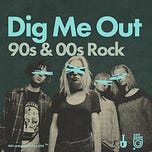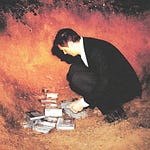Picture this: It’s 1999, and while the world obsesses over Britney, Limp Bizkit, and Y2K paranoia, a curly-haired Canadian is holed up in a Toronto basement, building sonic cathedrals with nothing but a Tascam 8-track and an unshakeable belief that being different is a superpower.
The millennium was ending, but Hawksley Workman—born Ryan Corrigan in the small Ontario town of Huntsville—was just getting started. His debut album For Him and the Girls landed in September 1999 like a glam-rock meteorite from another dimension, challenging every assumption about what indie music could be.
The One-Man Orchestra
What makes For Him and the Girls so fascinating isn’t just what it sounds like—it’s how it came to exist. In an era when bands were expected to have at least three members and a “sound,” Workman did something audacious: he played everything himself. Drums, bass, guitars, keyboards, vocals—even the occasional clarinet and trumpet from friends felt like guest appearances in his personal musical universe.
Working nights in a friend’s studio, Workman would start each song with a live drum performance, then layer instrument after instrument like a sonic archaeologist building ancient temples. The result was something that sounded both intimate and orchestral, lo-fi and ambitious—a bedroom recording that dreamed of the big stage.
The technical specs tell only part of the story: a Tascam ½-inch 8-track reel-to-reel, a Yamaha DX-100 providing those otherworldly sine wave bass notes, and countless hours of a young artist refusing to accept limitations. It was DIY as manifesto.
Genre? What Genre?
Trying to categorize For Him and the Girls is like trying to nail jello to a wall. Is it indie rock? Glam? Cabaret? The answer is yes, no, and “why are you even asking?” Workman drew from a palette that included David Bowie‘s theatrical flair, Tom Waits’ carnival barker intensity, and Queen’s operatic grandeur, then filtered it through a distinctly Canadian sensibility that was both earnest and playfully subversive.
The album opens with “Maniacs,” a song that begins with yodeling before morphing into something that sounds like a fever dream collaboration between Sparks and a very caffeinated torch singer. It’s the kind of opening gambit that either hooks you immediately or sends you running for something more conventional. Workman clearly preferred the former.
His vocal gymnastics throughout the record are genuinely impressive: falsettos that soar into the stratosphere, low crooning, and melodic passages that prove he could have been a straightforward pop star if he’d wanted to be boring. But boring was never the point.
The Songs That Time Forgot
Track by track, For Him and the Girls reveals an artist unafraid to follow his muse down rabbit holes. “Tarantulove” lurches with dark sexuality, “Sweet Hallelujah” unfolds like a lost cabaret standard, and “Safe and Sound” strips everything back to acoustic guitar and melody, proving Workman’s pop instincts were as sharp as his experimental edge.
The album’s 14-song, nearly hour-long runtime feels both generous and excessive—a debut album from an artist with so many ideas he couldn’t bear to leave any behind. Songs like “All of Us Kids” stretch past six minutes, while others clock in at barely three, creating a listening experience that’s more like a guided tour through Workman’s musical consciousness than a traditional album.
Perhaps most impressively, the whole thing holds together despite its stylistic wandering. The secret ingredient is Workman’s voice and vision—a theatrical sensibility that makes even the quieter moments feel like they’re happening on a stage somewhere between reality and dreams.
Ahead of the Curve
Here’s the thing about For Him and the Girls: it was probably the right album at the wrong time. Released in 1999, when alternative rock was still recovering from grunge’s hangover and nu-metal was starting to flex its muscles, Workman’s theatrical indie-pop felt like it belonged to a different conversation entirely.
In Canada, the album made Workman an instant cult figure. But south of the border, where radio programmers and A&R scouts were looking for the next Bush or Stone Temple Pilots, a yodeling one-man band with cabaret leanings didn’t compute. It would take more than a decade for the album to receive a proper U.S. release, by which time Workman had already released ten more albums.
The irony is that if For Him and the Girls had appeared just a few years later—say, 2002 or 2003—it might have found a more receptive audience. The early 2000s indie boom welcomed exactly this kind of theatrical, genre-defying artistry. Artists like The New Pornographers, Broken Social Scene, and Arcade Fire would soon prove that Canadian indie artists could set global trends rather than just follow them.
The Basement Prophet
What’s most remarkable about For Him and the Girls isn’t its ambition—plenty of artists are ambitious. It’s the way Workman achieved his vision with such limited resources, turning constraints into creative fuel. Every limitation—the 8-track setup, the solo recording process, the independent release—became part of the album’s DNA.
This was music made by someone who understood that authenticity isn’t about following rules; it’s about having the courage to break them in service of something genuine. Workman didn’t just make an album—he created a world, complete with its own logic, its own emotional landscape, and its own definition of what rock music could be.
The influence extends beyond the music itself. Workman went on to produce breakthrough albums for Tegan and Sara, helping shape the sound that would define Canadian indie for the next decade. His willingness to embrace both intimacy and grandeur, melody and experimentation, became a template for a generation of artists who refused to choose between being accessible and being adventurous.
Why It Still Matters
Nearly 25 years later, For Him and the Girls feels both of its time and utterly timeless. The analog warmth, the handmade quality, the fearless genre-hopping—these aren’t just period details, they’re reminders of what becomes possible when artists trust their instincts over market research.
In our current era of bedroom pop and lo-fi indie, Workman’s basement masterpiece sounds like prophecy. But it’s also a challenge: how many artists today are willing to be this weird, this committed to their own vision, this unafraid of alienating potential fans in service of something genuinely unique?
For Him and the Girls isn’t perfect—it’s probably too long, occasionally too theatrical for its own good, and definitely an acquired taste. But perfection was never the point. The point was magic, and magic is exactly what Workman conjured in that Toronto basement all those years ago.
Songs in the Episode
Intro - Bullets
17:05 - Maniacs
20:37 - Don't Be Crushed
23:07 - No Sissies
27:33 - Tarantulove
39:34 - Baby This Night
Outro - Bullets
Tom Waits - Bone Machine | Album Review
He's an outlier, an enigma, an iconoclast, an original. We're talking about Tom Waits, whose career is more closely tied to the 70s and 80s, but who released his Grammy Award-winning album Bone Machine in 1992 just as the first wave of grunge was talking off in 90s rock. Trying to compare Waits, and this album in particular, to any of his contemporaries…
#506: The Ponzi Scheme by Firewater
After the industrial noise rock of Cop Shoot Cop, lead singer/bassist Tod Ashley moved on to the eclectic sounds of Firewater, drawing on the sounds of American indie rock equally with European traditional music such as cabaret and Klezmer. With the help of future Gogol Bordello guitarist Oren Kaplan and a variety of skilled players, the band jumps from…
#261: Black Tie White Noise by David Bowie
It’s with heavy hearts we share with your are latest episode, recorded four days prior to the passing of David Bowie.
















